AMD A10-6700 And A10-6800K Review: Richland Hits The Desktop
Richland, code name for AMD's highest-end APUs, finds its way into our lab in the form of A10-6700 and A10-6800K. Based on the Piledriver architecture and VLIW4 graphics, these chips are slight improvements to Trinity. Can they outshine Core i3, though?
Results: F1 2012 And The Elder Scrolls V: Skyrim
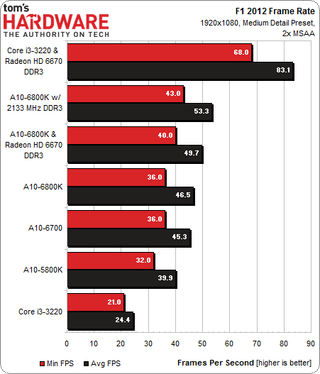
As far as average frame rates go, All of the APUs are playable at 1920x1080 using Medium quality settings, maintaining at least 30 FPS. As we might have guessed, using system memory running at 2133 MT/s makes an appreciable difference, slightly outpacing the same APU complemented by a discrete Radeon HD 6670.
We knew going in that HD Graphics 2500 would have been unplayable. Intel figured the same thing out quite a while after introducing its modest Core i3-3220; the -3225 didn't become available until quite a while after. The company redeems itself, however, when we drop in the same Radeon HD 6670, though. Alleviating the A10's processor bottleneck allows AMD's add-in card to achieve much higher frame rates.
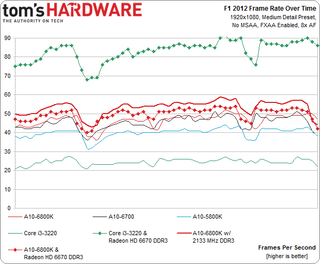
Charting frame rate over time gives us a clearer look at the peaks and valleys of each solution, though we don't derive any additional insight.
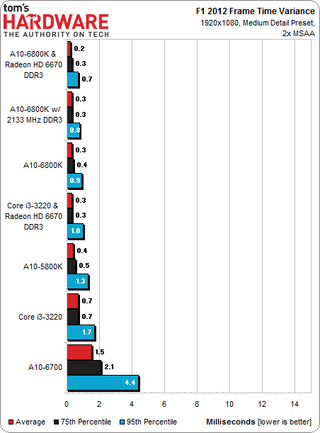
All of our tested configurations exhibit fairly low variance in the time it takes to render one frame to the next. Even when frame rates get slow, then, at least you have this consistency to look forward to.
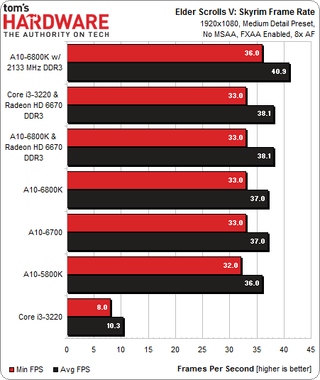
No surprise; Intel's HD Graphics 2500 implementation isn't cut out for gaming. For that, you'd want to look to HD Graphics 4000, at least.
But even then, data from Chris Angelini's review of Core i7-4770K shows that Intel cannot keep up with AMD's APUs in The Elder Scrolls V: Skyrim. It's not even close. HD Graphics 4600 doesn't even do the trick.
Faster memory isn't a huge deal for the AMD parts in this title, though we will note that the 2133 MT/s kit helps A10-6800K outperform Intel's Core i3 complemented by discrete graphics.
Stay On the Cutting Edge: Get the Tom's Hardware Newsletter
Get Tom's Hardware's best news and in-depth reviews, straight to your inbox.

The frame rate over time chart shows how 2133 MT/s memory helps push the A10-6800K to the top during this benchmark run.
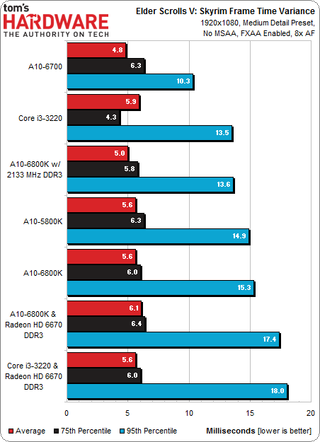
Unfortunately, playable frame rates don't guarantee smooth performance. When we look at worst-case scenarios, each one of these solutions incurs more than 10 ms of variance between frames. That's definitely a difference you're going to feel as you're playing. And indeed, our experience in Skyrim reflected relatively moderate consistency in how frames are delivered.
Current page: Results: F1 2012 And The Elder Scrolls V: Skyrim
Prev Page Results: Synthetic Benchmarks Next Page Results: Tomb Raider And Metro: Last Light-
esrever Numbering has never been for the architecture inside the chips. They have always been marketing for the current line of products. Normal people buy a laptop, they see the number, they get the performance associated with said number and they don't care about the inside of the chip. Richland is just a trinity refresh with better power management and higher clocks.Reply -
-Fran- No temps with power metrics page? 8(Reply
I guess Richland is still very hot going by the power figures alone. Still, it's a good step up (and stop gap) for AMD.
Nice review still. Are you guys planning on a follow up for Dual Graphics? 8)
Cheers! -
Wes Young Reply10920935 said:This is dumb. Still 6670 max card for dual graphics. Disappointing.
No, since driver 13.1 even the 5800k was able to run dual graphics with a HD 7750. I am typing on a system with that exact setup right now. I am not sure if the 6800k will allow anything above the 7750 though. When I tried a 7770 with the 5800k I wasn't given the option to enable dual graphics.
Most Popular

